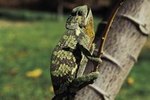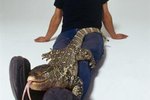
Monitors (Varanidae), sometimes called goannas, are lizards somewhat reminiscent of dinosaurs, that first appeared in the Cretaceous period. Represented by approximately 40 living species, monitor lizards are found in Africa, South Asia and Australia. The term goanna is reserved for Australian monitor lizards, but the terminology doesn't reflect any biological significance; goannas represent a number of sub-lineages, some of which have close relatives on other continents. While monitor lizards clearly have long lifespans of up to 25 years, concrete data is rare; definitive answers await more detailed investigation.
Mortality of Monitors
There is little data available regarding the mortality of monitor lizards in the wild. Eggs are consumed by a number of mammals and other monitor lizards. Small or young monitors have a number of predators, including hawks, snakes and larger monitor lizards. Additionally, carnivorous mammals, notably otters (Lutrogale perspicillata), are known to attack the lizards, presumably for both consumption and to exclude the lizards as competitors. Large monitor lizards have few natural enemies, but humans (Homo sapiens), crocodiles (Crocodylus sp.) and wild cats sometimes hunt adult lizards. Sometimes monitor lizards are killed by vehicular traffic in developed areas.
General Trends for Large Animals
Though the reasons for the phenomenon are still debated, in many evolutionary lineages, larger species tend to live longer than smaller species do. As some monitor lizard species are the largest lizards on the planet, it stands to reason that they will exhibit the longest life spans. In fact, from the data available, it appears that two very large species, Komodo dragons and perentie goannas (Varanus giganteus), have two of the longest recorded captive lifespans of all monitors, measuring 25 and 19.7 years, respectively. This is contrasted by the maximum recorded lifespan of smaller species like the Dumeril's monitor (Varanus dumerili) with a maximum recorded lifespan of 10.7 years, and the tiny Timor monitor (Varanus timorensis) that has a maximum recorded lifespan of 14.9 years.
Delayed Maturity
Another general trend in many animals is that those that mature and reproduce early tend to have short life spans, whereas those that take some time to reach maturity, often live long lives. While small monitor lizards like spiny tailed goannas (Varanus acanthurus), may reach maturity in one or two years, the larger species, like the lace goanna (Varanus varius), can take up to eight years to mature. This coincides with the scant available data for lifespan, in that the lace goanna is documented to live longer than many smaller species like the spiny tailed goanna.
Captive Monitors
The best data available for monitor lizard lifespan is that which comes from captive monitors. A number of species have been recorded to live up to 15 years in captivity, but it is important to note that captive monitor lizards have a different lifestyle than their wild counterparts. Captive monitor lizards are provided with food, veterinary care and protection from predators, which reduces overall mortality. A 2012 study by R.W. Mendyk, A.L. Newton and M. Baumer, looked at mortality in captive monitors that died at the Bronx Zoo, over a 39 year period. The study, published by Pub Med. showed that 47% of the deaths were due to infection of some variety. Additionally, reproductive complications were identified as the cause of death in approximately 11% of the female animals surveyed. Whether this reflects the reality for wild monitors is uncertain.
Wild Monitors
It is not possible to determine the age of adult monitors in the wild. Unlike trees or turtles, goannas do not have any annual growth rings. While a few mark and recapture studies have been conducted, the longest interval of time that has passed between an initial mark and later recapture is approximately eight years for a Komodo dragon (Varanus komodoensis). The Smithsonian Zoological Park predicts that wild Komodo dragons may live up to 30 years, but notes the need for increased study and verification.
References
- Duke Department of Mechanical Engineering and Materials Science: Bigger Creatures Live Longer, Travel Farther for a Reason
- Fauna of Australia: Family Varanidae
- Pubmed.gov: A Retrospective Study of Mortality in Varanid Lizards (Reptilia:Squamata:Varanidae) at the Bronx Zoo: Implications for Husbandry and Reproductive Management in Zoos
- Smithsonian National Zoological Park: Komodo Dragon
- Otter Specialist Group: Predation of Water Monitor Lizard (Varanus salvator) by Smooth-Coated Otter (Lutrogale perspicillata) in Penninsular Malaysia.
- Goannas: The Biology of Varanid Lizards; Dennis R. King and Brian Green
- Journal of Experimental Biology: Body size, Energy Metabolism and Lifespan
- Human Ageing Genomic Resources: AnAge: The Animal Ageing and Longevity Database
- Switchzoo.com: Nile Monitor Lizards
Photo Credits
-
Hemera Technologies/Photos.com/Getty Images



